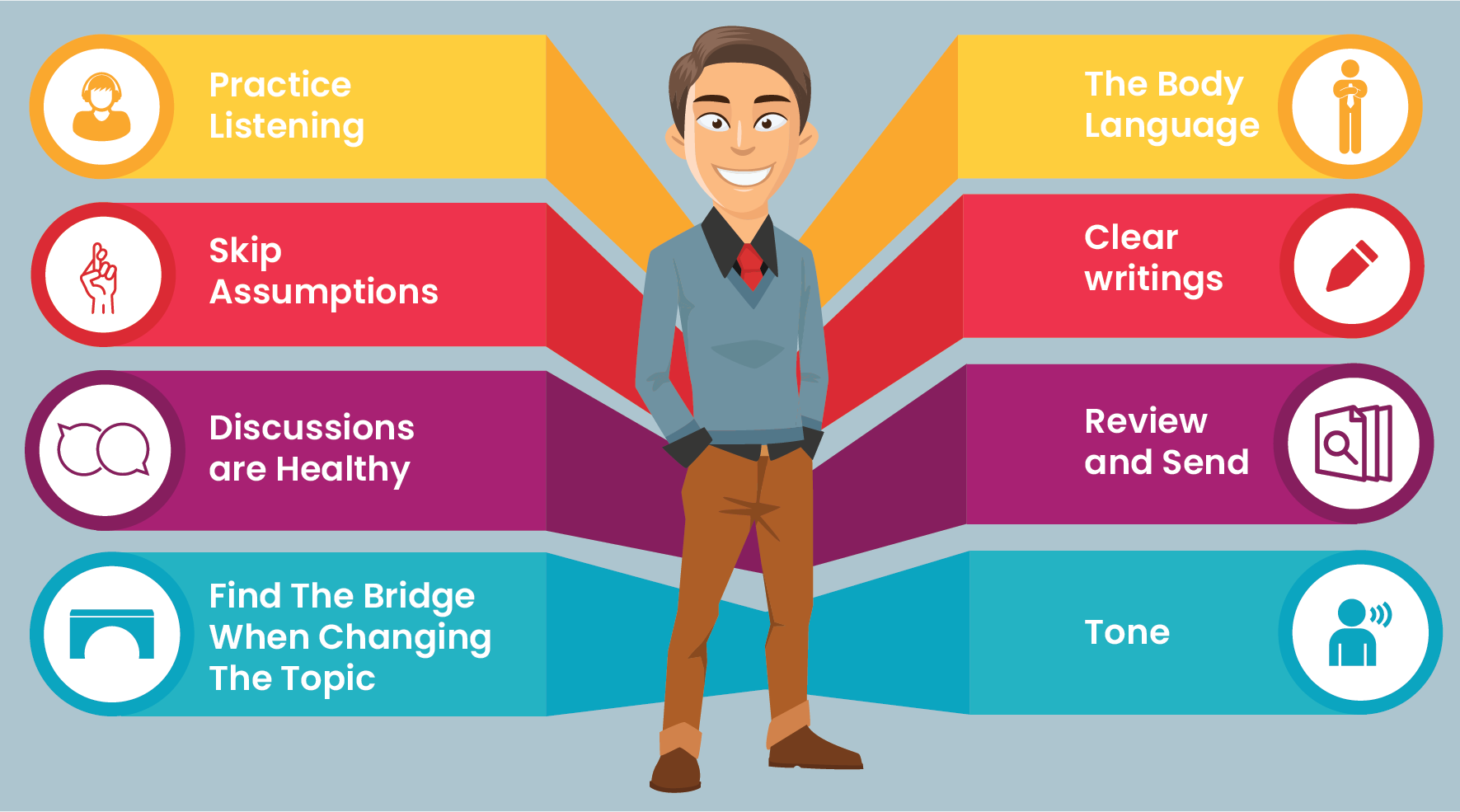8 Ways to Improve Your Communication Skills
Communication as a concept goes way beyond dropping a message or making a call. According to experts, a substantial portion of our daily communication is non-verbal. However, overall good communication skills both verbal and non-verbal, rank first among the top 10 employability skills for new hires.
While building personal relationships may be innate, business communication skills are not. They can be learned and mastered with practice.
Here are 8 easy ways to improve your communication skills:

-
Practice Listening:
Active listening is crucial to improving your communication. An active listener is able to understand the message their communication partner is sending and respond in a more meaningful way. Active listening means you have your complete attention. Make it a regular practice to listen to people with all your attention.
-
Skip Assumptions:
When in doubt, ask! Like Nat Turner says- “Good communication is the bridge between confusion and clarity.” It is very easy to assume that you know what the other person wants, but more often than not, assumptions lead to conflict. When in doubt, ask questions, request clarification, or summarise. Be sure that what you understand is the actual intention.
-
Discussions are Healthy:
Conflict in any setting is bound to happen for a simple difference of opinion. Even when you know someone is completely wrong, try and keep your cool during the discussion. Starting conversations with accusations is a clear invitation to fight. Attacks are almost always met with defense. Such conversations lead nowhere and nothing good can come from it. For effective communication, drop the accusations and communicate instead. Good communication on conflict opens the door to solutions.
-
Find The Bridge When Changing The Topic:
There are times when you may want to change the topic of conversation because it’s a difficult subject, it’s not appropriate for the situation, or it makes you feel uncomfortable. Abruptly changing the topic with new information may more often break a link in the conversation. If you do have a topic in mind, try and look for a bridge between where the conversation is now and where you want to take it. Be smart and subtle when you do it.
Quick Hack: Use phrases like - “while I understand what you’re saying, but I think….” and then establish where you plan to take the conversation. To close the conversation, summarize it. “Well, the important thing is…” is one of the most subtle ways to close a conversation.
-
The Body Language:
Body language is as important as verbal communication. It helps break the communication barrier of unfamiliarity and builds a better connection with the receiver. When your message matches your body language, the meaning is understood well. Firm handshakes, eye contact, posture, smiles are all the signals that contribute to adding meaning to the message. While you focus on your body language, make sure you observe the other person as well. It’ll help you understand when you’re making them uneasy or when the conversation needs to stop
-
Clear writings:
Imagine getting an email with no subject line. Or a message that reads “the task was completed”. Keep your writing professional and crisp. Add that subject line, so the recipient knows what message they’re in for. Effective communicators will draft and target their message based exactly on who they are speaking with.
Quick Hack: One of the best ways to keep your message crisp and clear is to address the 5W’s and 1H of communication. The W’s are “Who, What, Where, When, Why” and the H is “How”. If your writing conveys these 6 answers clearly, half the job is done. If the recipient needs any further clarification, they’ll come up with a question that you can answer.
-
Review and Send:
Always check your message before you hit send. Not every platform gives you the chance to undo your last move. The most common encounters you might’ve had are with emails that have a “PFA” in them with no attachment, or a half-drafted email sent mid-sentence.
Quick Hack: A personal practice that you can follow here is to draft the whole email, check for grammar and spelling, attachments and necessary links and add the recipient’s email address in the end. This way, you’ll cover all gaps that may otherwise arise.
-
Tone:
Your tone is crucial to communication-no matter who you are speaking to. If the message you receive is instigating or can gauge a powerful and disrespectful response, take a 5-minute cooling-off period and then come back to it so that your tone is respectful.
Maintaining this basic practice will always present you as somebody with whom people are willing to communicate both on the personal and professional front.
Effective communicators are not always the ones who can answer, but also the ones who can ask good questions. The entire communication funnel is about sending the right message to the right receiver through the channel at the right time. A basic practice that if not gifted, can be learned.
At SkillStone, we are equipped with all the right training channels to help you become industry-ready. Sign up for a quick session today!




